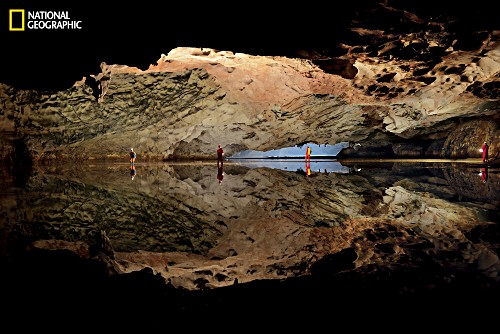Note: The original story can be found at http://www.nationalgeographic.com/china-caves/ and all images are from the July Issue of National Geographic magazine.
I don’t know if you keep up with National Geographic, but you probably should because they remain one of the best publications going, even well into their run. For instance, see the rad new story they posted on their website this month about an expedition to explore some very large, very dark caves in southern China. It features a beautiful modern design, interactive videos, and a new-to-the-public technology near and dear to our hearts: LiDAR. National Geographic, that old stalwart, has published an article that makes laser scanning look downright magical.
Members of a British-led expedition pause at a subterranean lake on the way to Titan Chamber in southern Guizhou Province, where it rains more than 50 inches a year. The lake appears and disappears as the rains come and go.
The story follows Andy Evis, chairman of the British Caving Association, as he brings a team of ten cavers into a system of cave chambers in the Guangxi region of China. They carry along with them some “well-worn caving bags overloaded with new laptops, batteries, and a rented 3-D laser scanner worth more than $100,000.” Yes, these cavers are crazy enough to drag a RIEGL VZ-400 through miles and miles of pitch-dark, treacherous, muddy territory. Why? Because the scanner allows them to do something that no one in human history has ever done before.
Much like using a 3D scanner to document a crime scene, a building, or a parcel of land, using a 3D scanner to document a cave allows us to measure it with extreme precision. But the truly amazing thing about a laser scanner is that it allows us to document the caves at all. Remember, the chambers these cavers are exploring are dark as night. Describing one of these chambers, the article’s writer says: “I can see that it is big simply because because I can’t see much at all; no longer does my light bounce off a ceiling or walls.” This is what makes LiDAR so exciting in this application–The technology can sense something that is invisible to the human eye and then make it visible to the human eye. If you look at the interactive features attached to the article (and I think these should be mandatory viewing), you’ll see a rendering of a space that no human alive or dead has ever seen before 2014.
The article is extremely cool, but it also does a few wonderful things for the cause of 3D-scanning technology. It captures the imagination by showing how 3D scanning can be a tool to extend the reach of human knowledge. It demonstrates the benefits of modernization to even the stubbornest professionals, because the adoption of these tools are allowing cavers to solve problems that they’ve never been able to solve. For instance, for the first time they can start accurately ranking cave chambers by volume rather than cobbling together an approximate ranking based on imperfect measurements taken by hand. This is a very big deal to them.
The other great thing the story does for the technology is pretty underhanded. It gets us all worked up to read about some intrepid explorers (after all, who doesn’t love a story about astronauts, arctic adventurers, or whip-cracking anthropologists?) and then sneaks in a quick (though very basic) primer about how 3D-scanning technology works. It explains that the RIEGL scanner measures using pulses, taking over 100k measurements per second of everything within 2,000 feet. It explains that the scanner can not see around corners. This most likely isn’t news to you, but it is news to most of National Geographic’s readership, many of whom now actually understand something about how laser scanning works. Only good things can come from giving the public (which maybe includes some potential clients) an education on this technology. Also, I can’t be the only one who would miss the weird looks I get when trying to explain LiDAR at parties.
If none of that seems exciting to you, just be glad that the story has stolen some public attention from the über-trend of 3D printing and directed it toward something more pertinent to your livelihoods, even if only for a little bit.






